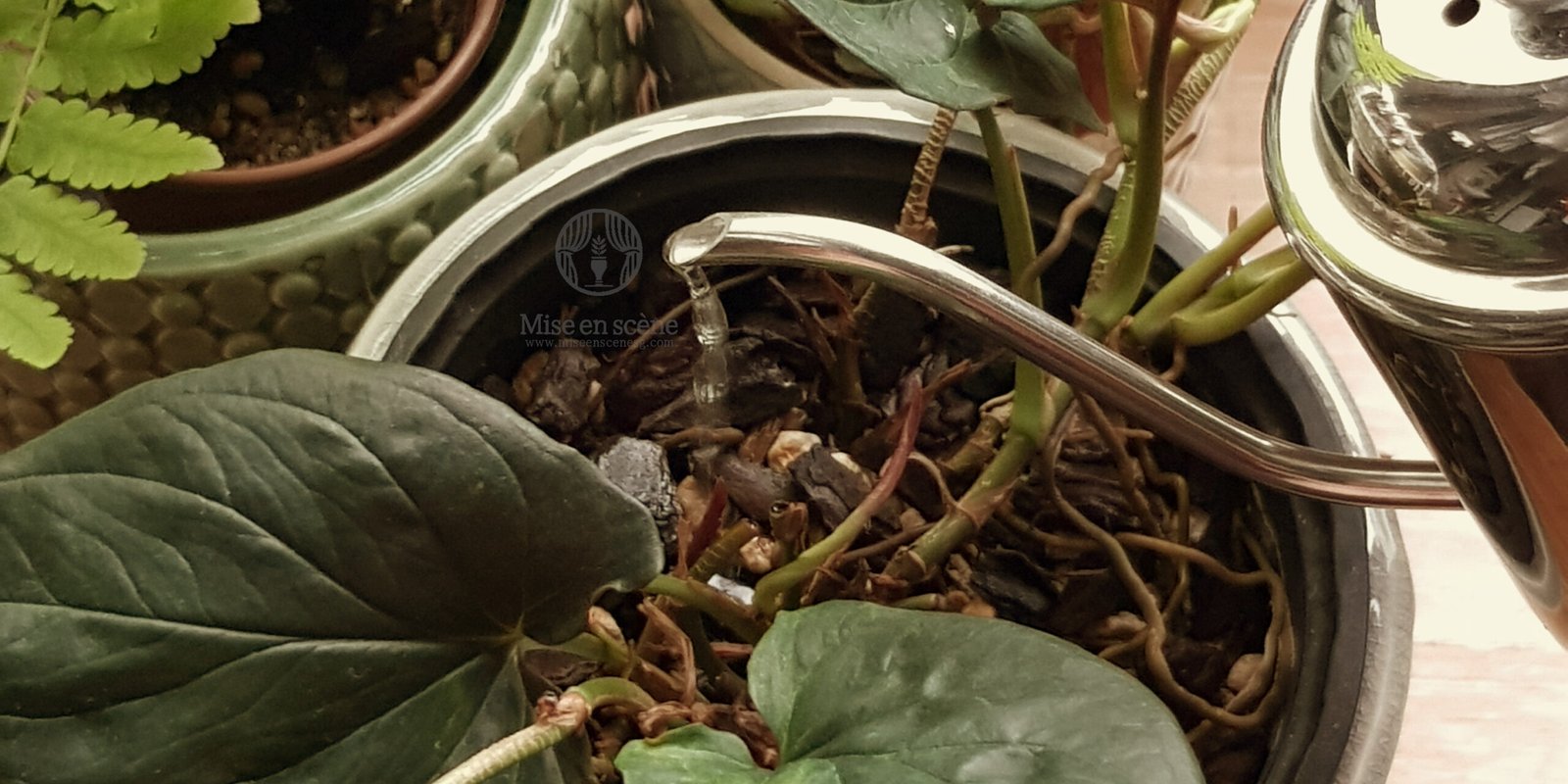Shopping Cart
No products in the cart.

Do you want the simple answer? Like the garden centres from which you bought your plants, whose staff tells you to “water once a day / week”. And then somehow, following their advice, after a short while your plant dies, from over-watering or under-watering. The only correct AND simple answer to this question is – it depends. If you spend some time reading this article, you will realize that it is a really complicated answer, but it is worth learning about this, because it is the single most important skill to unlock the next level in making your house plants survive, or even thrive.
Professional growers water their plants very carefully. The type of plant, stage of growth, growing environment (light, humidity, temperature), season, type of potting medium, size of the pot (which affects the amount of potting medium held), etc, all affect how much water needs to be given, and how often. Did you know there are even terms (e.g. “field capacity”) to describe how well-watered the plants are? Yes, just because you drenched the potting medium, it doesn’t mean that the water in the potting medium is always easily available to the roots of the plants. This is because different potting mixes have differing Soil Matric Potential (SMP). Tensiometers are therefore deployed to tell them in absolute terms whether each particular plant is drinking right.
While we aspire to grow great plants, most of us won’t have the resources to do it like the pros. So what are the alternatives?
Water them when you feel the plant looks thirsty, more often when it gets hot, less when it gets cold. Or water them because you are feeling sad, because watering plants makes you feel useful or connected again. Or water them when it is convenient to you. Your mileage, in these scenarios, will vary. By a lot.
Which is why you see a lot of overwatered plants in garden centres, which are manned by overworked staff who water the plants not because they need water immediately, but because they won’t have time to come back and check on them individually. They water everything when they make their rounds because they know their bosses will immediately notice a withered plant, but may not detect an overwatered plant without closer inspection. That is essentially “How to Keep your Job 101”.
You can do better.
Water the plant when it NEEDS water.
Which brings us to the most important question: How do we know the plant needs water when it doesn’t speak? Here are some guidelines:
※ The hotter, brighter and dryer(windier?) the environment the plant is in, the faster it will consume water.
※ The more loose, porous or chunkier the potting medium is, the less water it will retain, and for a shorter duration.
※ The more potting medium is in the container (i.e. bigger, deeper pots), the more water it will retain, and for a longer duration.
※ The more developed the plant is (e.g. in terms of foliage area), the more it tends to consume water.
Most importantly, observe your plant before and after watering.
To go as close to how the pros do it as possible, here are some steps everyone can follow:
Feel the potting medium by sticking your finger at least 2 cm deep into it. If it feels moist, generally for houseplants, it is unnecessary to water. With this method you are actually estimating how wet the soil below the 2cm is, by inferring from the wetness/dryness of the surface layer. It is never 100% accurate, but it is what every plant owner can easily do.
Of course, it also depends on the plant. This method may not work well for outdoor plants exposed to direct sunshine, because it may feel moist now, but very quickly, before you remember to check them again, they would have withered in the heat.
Feeling for moisture is also not necessary for those plants which require the substrate to be always wet (think bog or marsh plants like Venus flytrap, Indian Pennywort, Colocasia).
The other caveat is larger plants in deep pots, or pots with diameters more than 24 cm in general. This is where your finger won’t tell you an accurate-enough picture. Some use a chopstick stuck halfway into the full depth of the pot. When extracted, if potting medium particles stick to the chopstick, it means it is still wet. Unless your deep potted plant happens to love soggy soil, it isn’t time to water yet.
For more accuracy, invest in a reliable electronic moisture meter, preferably one with a longer probe so that it can actually give you a better gauge of the moisture level at least ¾ of the depth of the pot, even for deeper pots. They are still not as accurate as tensiometers as the measurement may be skewed by the porosity of the potting medium, but between them, your finger and your chopstick, you have a much better chance at catching that silent whisper your plant is trying to let out: ‘No!!!…..i’m not thirsty yet!’
But if the above methods tell you the plant is indeed in need of water, what’s next?
To make it simple, it is mostly a good idea to water such that the potting medium is fully saturated. This means you should see water seeping out of the drainage holes from the bottom of the pot. Especially for potting medium fresh out of the pack, you should repeat this saturation at least twice, with a gap of about 5-10mins (depending on the drainage speed)
Alternatively, do bottom watering. Sit the pot in a large container (with no holes obviously) of water that covers at least half the depth of the pot. Let the plant drink slowly. How long it would take depends. Your cue to stop is likely some time after you notice that the surface of the potting medium is already thoroughly wet.
For oversized pots (i.e. those plants that are too small for the pot), deeper pots or plants which do not tolerate soggy soil, it is better to measure a very conservative volume of water and water only that volume consistently. For example, a 1.5m Dracaena Gymis in a 35cm diameter pot placed beside a window with not much light could actually require as little as 100 ml of water or less per watering.
Hurray! You have just watered your plant in a timely manner! It has been fun! Can you do it again soon?
Not until you go back to Step 1.
Once you have determined that it is really time to water again, proceed to Step 2. Count the number of days between your consecutive Step 2s. Was it one week? Was it 3 days? Has it been 2 weeks already??!!! These scenarios are all possible, depending on the plant type, amongst other factors. Once you have established the number of days between waterings for each plant, note them down. For those Forgetful Freds or Impulsive Imeldas, write it on a sticker and place it on the pot, e.g. “water every Thursday”.
This calibration process makes your life easier and lets your plant heave a sigh of relief. This means you don’t really have to go back to Step 1 every time before you go to Step 2. This is of course, provided that you 1) did not change the environment in which you place that plant and 2) the plant has not grown (or shrunk) significantly and has remained healthy and 3) you did not change the potting medium or pot size the plant is in.
What about self-watering pots and the like? Feel free to experiment as again your mileage may vary wildly, since the type of plant, type of potting medium, potting medium volume, and the design of the self-watering pot can make the issue even more complicated.
If you need automated watering (e.g. when on vacation), there are many products out there nowadays. For example, weather-responsive, solar-powered pumps, tap or pump-based water timer with multiple independent irrigation lines for varying water needs of your plant collection, or even ceramic cones that automatically water your plants based on the principle of tensiometers. We decline to mention any brand names as the intention is merely to share information.
